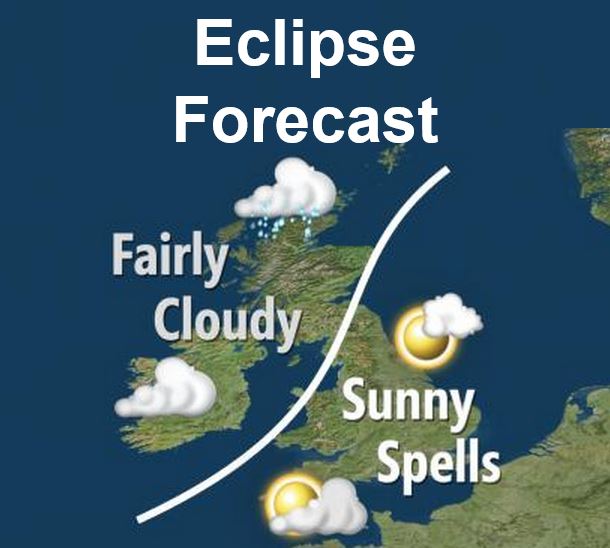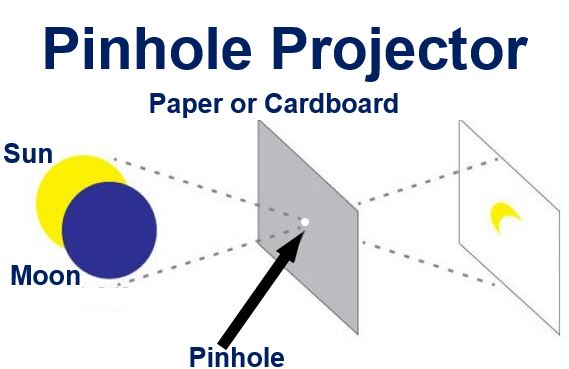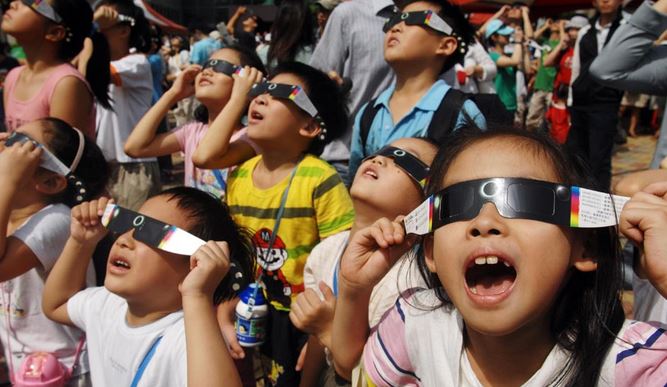As solar eclipse frenzy hots up, Britons are wondering anxiously what the weather will be like on Friday morning, March 20th. Early forecasts point to fairly cloudy skies in the northern and western areas of the country, while the south and east may enjoy clearer conditions, says the Weather Network.
Even if it is overcast on the day and you won’t be able to see the eclipse, everything will still go dark and you can watch the birds as they all fly back to their nests in the middle of the morning.
On March 20th, several phenomena will occur at the same time. There will be a Supermoon Eclipse – not only will there be a solar eclipse but also a Supermoon, when the Earth and Moon are as close to each other as they can be.

Things are looking better for people in the south and east. (Image: Weather Network)
The event will also coincide with the Spring Equinox, something that will only happen three more times this century (2034, 2053 and 2072) and not once in the 22nd century.
UK will have a partial solar eclipse
The UK’s partial eclipse will range from 98% darkness (obscuration) in the far north of the country, specifically in the Isle of Lewis in the Outer Hebrides, to 85% in the most southerly tip.
People across the rest of Europe, North and West Africa and Northern parts of Asia will also experience varying degrees of obscuration.
Further north, Svalbard (between Norway and the North Pole) and the Faroe Islands (between Norway and Iceland) will have a total eclipse – 100% obscuration.
Authorities in the Faroe Islands say that although their hotels, B&Bs and hostels are now all fully booked, there are still some host families available.
The Faroe Islands Tourist Board wrote in a statement:
“The event will be celebrated by the Faroese and tourists all across the country. After the solar eclipse, the remainder of the day will be packed with a wide variety of cultural- and musical events, tours, activities and opportunities to try local Faroese foods, among other things.”
What is a solar eclipse?
During a solar eclipse the Moon comes in between the Earth and the Sun, thus blocking out sunlight and making parts of our planet go dark.
Two shadows are cast on the Earth’s surface:
The Penumbra: this shadow covers a large area but is not so dark – a partial solar eclipse.
The Umbra: this is a small and much darker shadow – a total solar eclipse.

The moon casts two shadows on the Earth’s surface during a solar eclipse.
The Faroe Islands and Svalbard will be in the umbra, while the UK and the rest of Europe will be in the penumbra.
The partial eclipse in the UK will start at 7:41am and end at 11:50am, while the total eclipse will last just 2 minutes and 24 seconds, says the Met Office.
Make the best of Friday’s event, because there won’t be another one for 11 years (August 11, 2026).
The British Astronomical Association (BAA) informs:
“An obvious partial eclipse will be visible from every country in Europe and the partial phase will also be seen from places as widely spread as Newfoundland, North Africa and north-western Asia.”
Eye damage
Authorities across Europe are reminding people to take safety measures to protect their eyes. Remember never to look at the eclipse with the naked eye. If you do there is a risk of eye damage, and even blindness!
Scientists at the US space agency NASA offer the following advice:
“The Sun can be viewed safely with the naked eye only during the few brief seconds or minutes of a total solar eclipse. Partial eclipses, annular eclipses, and the partial phases of total eclipses are never safe to watch without taking special precautions.”
“Even when 99% of the Sun’s surface is obscured during the partial phases of a total eclipse, the remaining photospheric crescent is intensely bright and cannot be viewed safely without eye protection.”
The BAA says:
“DON’T view the Sun through sunglasses of any type (single or multiple pairs), or filters made of black & white or colour photographic film, or any combination of photographic filters, crossed polarisers or gelatin filters, CDs, CD-ROMs, or smoked glass. These are NOT safe.”
“DO view the Sun ONLY through special filters made for safe solar viewing, e.g. aluminised mylar filters, or black polymer filters, identified as suitable for direct viewing of the Sun, bearing the CE mark AND a statement that it conforms to European Community Directive 89/686/EEC, or use a welder’s glass rated at No. 14 or higher. Always read and follow the manufacturer’s instructions carefully.”
Young kids: are likely to succumb to the temptation to look up, regardless of how many times they are warned of the dangers. Do not let young children enjoy the event without adult supervision.
How to enjoy a solar eclipse safely
Pinhole camera: also known as a pinhole projector, allows you to see an inverted image of the eclipse. All you need are two sheets of paper and a pin.

Supervise young children when they make the camera (the pin!).
With the pin make a hole in the middle of one sheet. Hold the paper up to the Sun and the other one below it. An inverted image of a partially-blocked Sun will appear on the lower sheet.
Have your back to the Sun while you do this to protect your eyes.
Eclipse glasses: several online stores are selling them. They block out the harmful ultra-violet and infrared rays, and also reduce the intensity of visible light. Many stores are sold out, but this morning I noticed Amazon still has some in stock.

Make sure your eclipse glasses are CE approved.
Solar power industry says it is ready
When Europe goes dark on March 20th there will be a 35,000 MW dip in electricity generation as solar power plants stop producing electricity. Europe is the world’s largest generator of solar power.
This fall in supply will coincide with a rise in demand as people across the continent switch their lights on.
The European Network of Transmission System Operators for Electricity says:
“Managing this event on the world’s largest interconnected grid is an unprecedented challenge for European TSOs.”
“Solar eclipses have happened before but with the increase of installed photovoltaic energy generation, the risk of an incident could be serious without appropriate countermeasures, as was pointed out in ENTSOE’s Winter Outlook Report of last December.”
An eclipse legend from the Faroe Islands
In the Faroe Islands there is a legend about four shepherd brothers who used to quarrel incessantly.
One morning, at 11:25 am on May 30th, 1612, there was a solar eclipse while they were up in the mountains tending to their sheep.
When everything went dark the brothers thought it was the beginning of the end of the world and were overcome with sadness and regret.
They promised to God that if he could save the world and bring daylight back they would never fight again and would become better men.
A few minutes after their prayers the Sun came out and everything was normal again. They hugged each other and never squabbled again.
Video – Eclipse weather forecast
